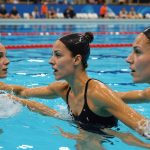Understanding Pre-Performance Anxiety in Ice Skating
Pre-performance anxiety, often referred to as ice skating nerves, is a common challenge faced by skaters. This form of anxiety arises from a combination of psychological and physiological factors. Anticipation of performing in front of an audience, fear of making mistakes, and pressure to succeed are key contributors to this anxious state.
Pre-performance anxiety can significantly affect a skater’s technique and overall performance. It can lead to a decreased mental focus, making it difficult for skaters to execute complex moves with precision. Moreover, the physical symptoms such as increased heart rate, sweating, and muscle tension can impede performance fluidity.
Also to discover : Mastering the art of spins: elevate your ice skating with targeted strength training strategies
Recognizing symptoms of anxiety before stepping onto the ice is crucial for skaters. Some signs include racing thoughts, restlessness, and a sense of dread or panic. By understanding these symptoms, skaters can better address their anxieties and implement strategies to manage them effectively.
Understanding and managing ice skating nerves is essential, as it forms the foundation for executing successful performances. Equipping skaters with tools to build their mental focus allows them to skate with confidence and poise, transforming anxiety into an asset rather than a hindrance.
Have you seen this : Mastering Breath Control for Synchronized Swimming: Top Techniques for Underwater Excellence
Breathing Techniques for Ice Skaters
To combat the pre-performance anxiety known as ice skating nerves, incorporating effective breathing exercises can be transformative. One popular method is diaphragmatic breathing, which promotes mental focus and physical relaxation. This simple yet powerful exercise involves taking slow, deep breaths that engage the diaphragm rather than shallow chest breathing.
Effective Breathing Exercises
Begin by sitting or standing in a comfortable position. Place one hand on your chest and the other on your abdomen. Inhale deeply through your nose, feeling the hand on your abdomen rise while the chest remains relatively still. This indicates that you are breathing deeply into the diaphragm. Exhale slowly through pursed lips, ensuring a controlled release of breath.
By consistently practicing, skaters can integrate breathing techniques into their pre-performance routines, helping to manage anxiety and enhance performance. Regular practice cultivates control over breath and emotion, allowing skaters to remain calm and focused.
These calming techniques can significantly improve performance by reducing stress and aiding concentration. Adopting this approach as part of a thorough routine equips skaters with tools for better mental and physiological preparedness, transforming anxiety into heightened performance poise.
Visualization Strategies for Competitions
Incorporating visualization techniques is crucial for skaters aiming to boost their competitive performance. Mental imagery not only enhances confidence but also prepares skaters for the challenges of a competition setting.
Creating a Visualization Routine
To craft a visualization routine, skaters should begin by imagining themselves executing routines flawlessly. This exercise strengthens mental imagery skills, thereby reinforcing muscle memory. Performance enhancement through visualization involves mentally rehearsing every detail of the routine—right from stepping onto the ice to the final bow. Each aspect of the performance should be visualized vividly, including specific jumps, spins, and footwork.
Successful Examples
Many successful skaters attribute their achievements to consistent use of visualization techniques. For example, visualizing complex moves beforehand helps skaters confidently perform under pressure. This mental preparation can be as beneficial as physical practice. By integrating visualization into their pre-performance rituals, skaters develop heightened focus and a sense of preparedness that translates into seamless performances.
Visualization strategies, when applied effectively, have the potential to turn competition nerves into absolute confidence on ice. Skaters are encouraged to make visualization a regular part of their routine, aligning the mind with the body’s capabilities for optimal performance.
Relaxation Techniques to Enhance Focus
Maintaining mental calmness and enhancing focus for ice skaters can be significantly improved with specific relaxation methods. These techniques are tailored to the unique demands of ice skating, allowing athletes to reduce stress and sharpen their focus.
Types of Relaxation Techniques
There are various relaxation methods that skaters can employ, such as progressive muscle relaxation, meditation, and mindfulness exercises. Progressive muscle relaxation involves tensing and relaxing different muscle groups, helping to reduce tension. Meditation focuses on stillness and deep breathing, promoting a tranquil mind. Mindfulness exercises cultivate awareness of the present moment, enhancing concentration.
Creating a Personalized Relaxation Plan
To construct an individualized relaxation plan, skaters should identify which techniques resonate most with their needs. Combining different methods might yield the best results. Regular practice enhances effectiveness, integrating relaxation into daily routines to assure peak mental and physical readiness.
Expert insights reveal that implementing a consistent relaxation routine dramatically benefits skaters’ performance, boosting focus enhancement. Testimonials from coaches and experienced skaters underscore the substantial impact of relaxation techniques, showcasing their role in achieving mental clarity and composure. By embracing these techniques, skaters can strengthen their mental game, resulting in more composed and confident performances on the ice.
Expert Advice and Testimonials
Navigating the realm of pre-performance anxiety can be a daunting task for ice skaters. That’s why insights from expert testimonials and seasoned coaches offer invaluable guidance. These professionals emphasize the effectiveness of robust performance techniques tailored to individual needs.
Interviews with experienced skaters reveal that the key to managing ice skating nerves lies in personalized strategies. Many skaters share their experiences of incorporating specific exercises, such as mental focus practices, to calm nerves before stepping onto the ice.
Coaches offer a wealth of knowledge on mental preparation techniques, underscoring the importance of maintaining a consistent routine. They suggest integrating a blend of visualization techniques and relaxation methods to achieve a balanced mental state. This approach helps skaters transition anxiety into focused energy, enhancing their performance.
A summary of the insights gathered points to the significance of a structured pre-performance routine. Successful skaters consistently utilize a combination of breathing, visualization, and relaxation techniques. It’s important to adjust these practices according to personal needs and specific performance demands, ultimately leading to a more composed and confident demeanor on the ice.
Developing a Pre-Performance Routine
Constructing an effective pre-performance strategy is essential for ice skaters striving for consistency. A routine building forms the foundation of a skater’s competition preparation. Establishing a regular routine encourages mental and physical readiness, essential for success on the ice.
Consistency in Daily Routines
Consistency is crucial in a skater’s daily habits, fostering an environment where practice becomes second nature. Regular routines ensure skaters maintain their focus and hone their skills consistently. Incorporating a structured routine minimizes surprises and reduces anxiety before performances, leading to enhanced confidence.
Elements of a Routine
Key components of a personalized pre-performance routine may include warm-up exercises, visualization techniques, and mental imagery. Regular breathing exercises and relaxation methods also play a significant role in calming nerves. It’s important to match these elements with the skater’s unique requirements to maximise effectiveness.
Adjusting Based on Individual Needs
Each skater’s needs vary; therefore, routines should adapt to these differences and the specific demands of each performance type. Integrating feedback from coaches and personal experience aids in refining approaches, leading to optimal performance outcomes. By personalising routines, skaters can achieve a balance between technical skill and psychological preparedness, paving the way for success.











